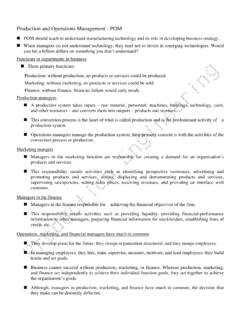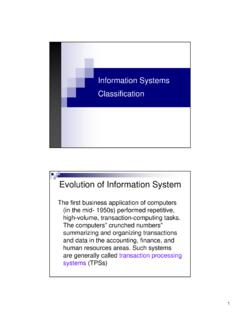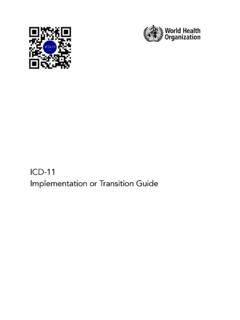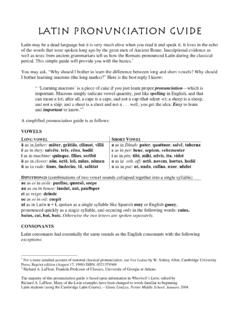Transcription of ICD-10 Second Edition Volume 2 - World Health Organization
1 ICD-10 InternationalStatisticalClassificationof Diseases andRelated HealthProblemsTenth RevisionVolume Second EditionWorld Health OrganizationGeneva WHO Library Cataloguing-in-Publication Data ICD-10 : international statistical classification of diseases and related Health problems : tenth revision. 2nd ed. 3 v. Contents: v. 1. Tabular list v. 2. Instruction manual v. 3. Alphabetical index. - classification Health Organization : International statistical classification of diseases : 10th revision : ICD-10 . Second Edition . ISBN 92 4 154649 2 (vol. 1) (NLM classification: WB 15) 92 4 154653 0 (vol. 2) 92 4 154654 9 (vol. 3) World Health Organization 2004 All rights reserved.
2 Publications of the World Health Organization can be obtained from Marketing and Dissemination, World Health Organization , 20 Avenue Appia, 1211 Geneva 27, Switzerland (tel: +41 22 791 2476; fax: +41 22 791 4857; email: Requests for permission to reproduce or translate WHO publications whether for sale or for noncommercial distribution should be addressed to Marketing and Dissemination, at the above address (fax: +41 22 791 4806; email: The designations employed and the presentation of the material in this publication do not imply the expression of any opinion whatsoever on the part of the World Health Organization concerning the legal status of any country, territory, city or area or of its authorities, or concerning the delimitation of its frontiers or boundaries.))
3 Dotted lines on maps represent approximate border lines for which there may not yet be full agreement. The mention of specific companies or of certain manufacturers products does not imply that they are endorsed or recommended by the World Health Organization in preference to others of a similar nature that are not mentioned. Errors and omissions excepted, the names of proprietary products are distinguished by initial capital letters. The World Health Organization does not warrant that the information contained in this publication is complete and correct and shall not be liable for any damages incurred as a result of its use. The 43rd World Health Assembly in 1990 approved the Tenth Revision of the International Classification of Diseases (WHA ) and endorsed the recommendation of the The International Conference for the Tenth Revision of the ICD held in Geneva from 26 September to 2 October 1989 concerning the establishment of an updating process within the 10-year revision cycle.
4 This recommendation was put into motion at the annual meeting of WHO Collaborating Centres for the Family of International Classifications in Tokyo, Japan in 1996 and later a formal mechanism to guide the updating process was established. According to this updating mechanism minor updates are made each year while major updates are made, if required, every three years. For more information regarding the updating process and a cumulative list of the updates please see Future updates will also be posted on this site. This Second Edition of ICD-10 includes the corrigenda to Volume 1 which appeared as an addendum to Volume 3 of the first Edition , as well as the updates that came into effect between 1998 and 2003.
5 Typeset by DIMDI in Germany and adapted for electronic use by WHO Print of this version is not permitted iii Contents 1. Introduction 1 2. Description of the International Statistical Classification of Diseases and Related Health Problems 3 Purpose and applicability 3 The concept of a family of disease and Health -related classifications 4 Diagnosis-related classifications 6 Non-diagnostic classifications 8 Information support to primary Health care 11 International Nomenclature of Diseases 12 The role of WHO 13 General principles of disease classification 13 The basic structure and principles of classification of the ICD 14 Volumes 15 Chapters 16 Blocks of categories 17 Three-character categories 17 Four-character
6 Subcategories 17 Supplementary subdivisions for use at the fifth or subsequent character level 18 The unused U codes 18 3. How to use the ICD 19 How to use Volume 1 19 Introduction 19 Use of the tabular list of inclusions and four- character subcategories 20 Two codes for certain conditions 21 Conventions used in the tabular list 24 Categories with common characteristics 27 How to use Volume 3 28 Arrangement of the Alphabetical Index 28 Structure 29 Code numbers 29 Conventions 29 Basic coding guidelines 30 4. Rules and guidelines for mortality and morbidity coding 31 Mortality.
7 Guidelines for certification and rules for coding 31 Causes of death 31 Underlying cause of death 31 lNTERNATlONAL CLASSIFICATION OF DISEASES iv International form of medical certificate of cause of death 32 Procedures for selection of the underlying cause of death for mortality tabulation 34 Rules for selection of the originating antecedent cause 34 Some considerations on selection rules 36 Examples of the General Principle and selection rules 37 Modification of the selected cause 43 The modification rules 43 Examples of the modification rules 45 Notes for use in underlying cause mortality coding 51 Summary of linkages by code number 64 Notes for interpretation of entries of causes of death 69 Assumption of intervening cause 69 Interpretation of highly improbable 69 Effect of duration on classification 72 Sequelae 72 Consistency between sex of patient and diagnosis 74 Operations 74 Malignant neoplasms 74 Rheumatic fever with heart involvement 89 Congenital malformations, deformations and chromosomal abnormalities 89 Nature of injury 90 Poisoning by drugs.
8 Medicaments and biological substances 91 External causes 91 Expressions indicating doubtful diagnosis 92 Human Immunodeficiency Virus (HIV) 92 Perinatal mortality: guidelines for certification and rules for coding 92 Certification of perinatal deaths 92 Statement of causes of death 94 Tabulation of perinatal mortality by cause 97 Coding of causes of death 97 Coding rules 98 Morbidity 101 Guidelines for recording diagnostic information for single-condition analysis of morbidity data 102 Guidelines for coding main condition and other conditions 104 Rules for reselection when the main condition is incorrectly recorded 111 Chapter-specific
9 Notes 117 5. Statistical presentation 129 Introduction 129 Source of data 129 Level of detail of cause in tabulations 129 The recommended special tabulation lists for mortality 130 CONTENTS v The condensed lists 130 The selected lists 130 Use of prefixes to identify the mortality lists 131 Locally designed lists 131 The special tabulation list for morbidity 131 Description 131 Modification of the special tabulation list for morbidity according to national requirements 132 Recommendations in relation to
10 Statistical tables for international comparison 132 Statistical tables 132 Tabulation of causes of death 133 Standards and reporting requirements related to fetal, perinatal, neonatal and infant mortality 134 Definitions 134 Reporting criteria 136 Statistics for international comparison 136 Presentation of causes of perinatal mortality 138 Standards and reporting requirements related to maternal mortality 139 Definitions 139 International reporting 140 Published maternal mortality rates 140 Denominators for maternal mortality 141 Proportion of deaths classified to ill-defined causes 141 Morbidity 141 Precautions needed when tabulation lists include subtotals 142 Problems of a small population 142 Empty cells and cells with low frequencies 143 6.

















